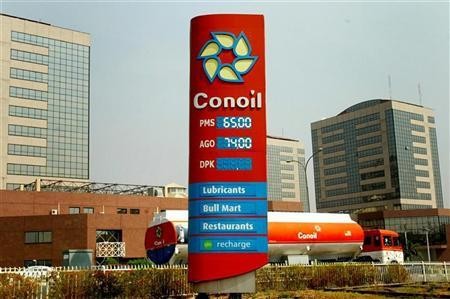Conoil’s earnings records in 2014 continued on the rise and fall pattern the company has followed in the past five years. The oil marketing company’s result for last year, which was released last week, shows that it was a down year in the business. Sales revenue dropped to the lowest level in four years and that slashed profit well below the figure the company showed shareholders at the end of the third quarter. This means the company’s last quarter operations ended in a big loss.
For a company to end a financial year with a lower profit figure than shown only three months to the end of the year is a big disappointment. It is misleading to investors who are normally expected to take decisions on the basis of the growth rate shown in the interims. This is more so when there is no extra ordinary occurrence in the final quarter reported in the accounts.
The company’s profit capacity was broken by an upsurge of administrative expenses in the final quarter. Over 40% of administrative cost in the year was incurred in the final quarter, which overturned the cost moderation the company showed at the end of the third quarter. The company generated over N24 billion in sales revenue in the last quarter and could not convert one kobo of it into profit.
Conoil closed the 2014 financial year with sales revenue of N128.35 billion, which is a drop of 19.5% from the company’s peak revenue of N159.54 billion it posted in 2013. Sales revenue figures show a pattern of rise and fall over the past five years and the figure for 2014 is only slightly ahead of the revenue figure in 2011. Inability to grow sales revenue is a general problem facing petroleum marketers for some years now.
Advertisement
The company reported an after tax profit of N834 million for its 2014 operations, which is a sharp drop of 73% from the N3.07 billion it posted in 2013. It also represents a drop of 41.6% from the third quarter profit figure of N1.43 billion. This is one of the lowest profit figures the company has reported in the last five years during which its profit has risen two times and fallen two times.
Apart from the drop in sales revenue, profit performance was also affected by a sharp drop of 94% in other operating income to N173 million in the year. This was partly remedied by a shift from other losses of N48.7 million in 2013 to other gains of N761 million in 2014. Another favourable development is a major cost saving from distribution expenses, which dropped more than twice as fast as sales revenue at 39.8%.
Two other major cost areas failed to drop with the drop in sales revenue and therefore undermined the company’s profit performance in 2014. The most critical is administrative cost, which declined only slightly and therefore claimed a significantly increased share of sales revenue. A moderate behaviour the company showed in respect of this expense line at the end of the third quarter changed suddenly at full year. Compared to N4.82 billion or 4.6% of sales revenue at the end of third quarter, administrative expenses jumped suddenly to N8.16 billion or 6.4% of revenue at the end of the year.
Advertisement
Finance cost is the second major expenditure that hurt profit performance in 2014. At about N2.31 billion, interest expenses increased slightly against the drop in revenue in the year. This means the company devoted an increased proportion of sales revenue to interest expenses during the year. The company’s borrowings doubled in the year at N22.65 billion.
The cost-income ratio grew significantly in the year, which cut down profit margin to one of the lowest among oil marketing companies. Net profit margin dropped from 1.9% in 2013 to 0.6% in 2014 compared to the sector leading profit margins of 9.1% for Mobil Oil, 4.1% for Forte Oil and 1.8% for Total Nigeria during the same year.
The company earned N1.20 per share at the end of 2014, down from N4.42 in the preceding year. It paid a dividend of N4.0 per share for the preceding year but no dividend has been declared for the 2014 financial year at press time.
Other major developments in the balance sheet in the year include a drop of 48.1% in inventories, an increase of 16.6% in trade and other receivables and a drop of 10.8% in trade and other payables. The company’s cash flow position weakened in the year with a drop from a huge net cash generation from operating activities in 2013 to net cash utilisation in 2014.
Advertisement
Add a comment







